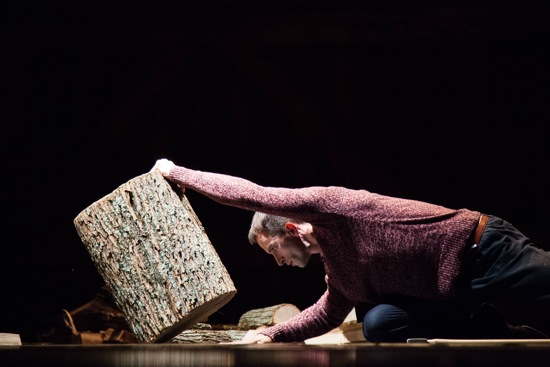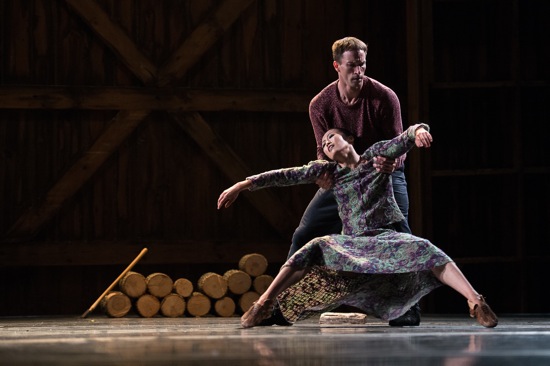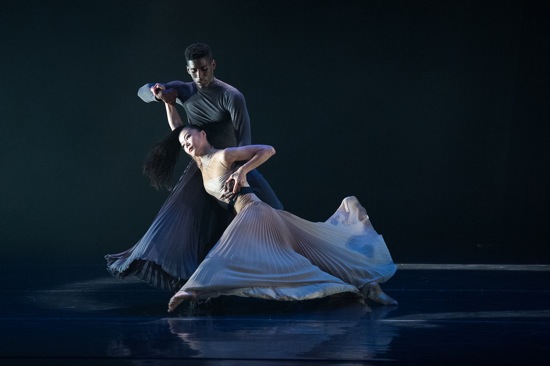The Martha Graham Dance Company presents new, recent, and classic works at Jacob’s Pillow.
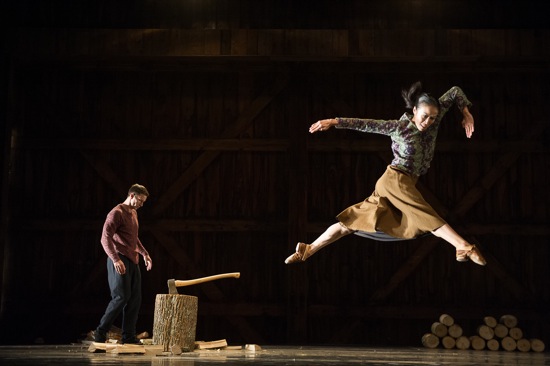
Ben Schultz and PeiJu Chien-Pott of the Martha Graham Dance Company in Mats Ek’s Axe. Photo: Christopher Duggan
The last week of Jacob’s Pillow’s 83rd anniversary season corresponded with the Martha Graham Dance Company’s upcoming 90th year, and MGDC appeared in the Ted Shawn Theater that August week. Anniversaries are meant as celebrations. I’m only sorry Ella Baff couldn’t wait until her 20th year as the executive and artistic director of the Pillow before leaving it. Over 17 years, she built its heath and fame through her commitment to broadening support, making smart choices of dance artists to perform in its two theaters and outside stage, and scheduling activities and exhibitions that educated audiences. Here’s a small example of her staff’s dedication to bringing spectators to dance (the one that makes me giggle). Inside more than one toilet stall in a Jacob’s Pillow’s restroom, you could read, taped inside the door, little hints about how to look at dance. That’s really not wasting a minute.
I celebrate all that Baff accomplished over those years and wish her well in her challenging and influential new position as Senior Program Officer for Arts and Cultural Heritage at the Andrew Mellon Foundation. She has made all who came in contact with her—that includes the audiences who applaud her curtain speeches at every performance—feel as if she were a friend of theirs; and, through her, they have become friends of dance.
The Martha Graham Dance Company profited from Baff’s vision. Axe, the world premiere by Mats Ek that MGDC presented in the Ted Shawn Theater, was commissioned by the Jacob’s Pillow Dance Festival (with generous support from Hellsten Hotels Stockholm).
The Graham company’s artistic director, Janet Eilber, made a bold choice in acquiring this duet that began life as a film (you can see a trailer for it at https://www.youtube.com/watch?v=k33z-sksBS4). Programmed with a superb performance of Graham’s 1958 Embattled Garden and two lesser works (Nacho Duato’s Depak Ine and Antonis Fodianakis’s Echo), the revised Axe, in contrast, looked—I don’t know quite how to say this—real. That is, for most of it, nothing exaggerated or elevated or mythologized or extraneous happened onstage.
For Axe, the undisguised rear of the stage is revealed as the rough wooden barn wall that it is. A stump with an axe in it sits at the center of the space, and there’s a stack of wood near the back. A man dressed in pants and a sweater (Ben Schultz) enters the stage with an unhurried, everyday walk. He’s got a job to do and attacks it with dogged precision. His intent is to split wood, and it’s amazing to watch him do it. He stands a log on the stump and places himself at a certain distance from it— in profile to us and in a wide stride, his left foot forward. He raises the axe, aims, and brings it down, whap! The log splits in two. Then he picks up the halves and splits each again.
He does this over and over and over, and only once on the night I attended the performance, did he fail to complete a cut. Virtuosity redefined.
Eventually, there is music aside from the fall of the axe. Very sweet, moderately repetitive music—the kind that promotes nostalgia. It has its own history. The Adagio in G minor that the program attributes to 18th-century composer Tomaso Albinoni is actually by Albinoni’s 20th-century biographer, Remo Giazotto and supposedly based on a small fragment of manuscript. Ek’s dance is performed to a version of Giazotto’s score by the venturesome Swedish group Fleshquartet (four string players, a percussionist, and some electronic meddling).
A woman (PeiJu Chien-Pott) enters with her back to us, taking little crabbed side steps. She wearing a workaday sprigged dress and small boots. Is it because he heard her coming that the man miscalculates that one blow of the axe? The stage by now is littered with split wood.
What’s interesting is that, for a long time, the man doesn’t appear to see this other human being no matter how close she comes. When he’s at the stack, she sits on the stump; he returns and pauses; she gets up and he splits another log. She takes and cradles a log that he intends to cut and, traveling with little steps, carries it away. At this point, you may wonder who this woman is, even wondering if she could be the spirit of the wood he is cutting.
But something is boiling up between these two. Once, when she has temporarily left the space, he lies back over the stump and, stiff as a board, walks on air. Mysteriously, a stagehand dumps a load of split wood, and once, the man stumbles his way up the pile. All this wood, you think. Winter is coming, you think. Days, weeks, years of it. But when the two people shake, it’s not from the cold. You realizethat they form a couple, long locked into a taciturn, withered relationship.
The woman does dance—not just with those jerky little hops, but with big, despairing gestures of her whole body. The two connect, sometimes in odd ways. He handles one of her legs as if it were another piece of wood, twists her foot until she’s lying on the floor. He lies down too, but both of them look as stiff as the logs themselves. In the end, he stands numbly while she loads his arms with firewood—almost more than you think he can carry. He walks off the stage, and she follows, holding the axe.
The performers in the film are mature dancers: Ana Laguna and Yvan Auzely. Their tragedy, whatever it was, had grown with the years. But Chien-Pott and Schultz inhabited their roles with a simplicity and a stoicism that could break your heart.
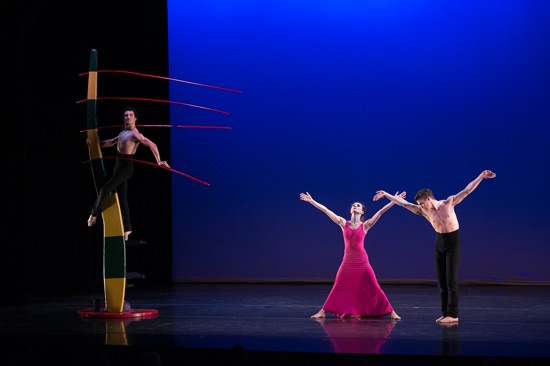
Another cast at Jacob’s Pillow in Martha Graham’s Embattled Garden. (L to R): Lorenzo Pagano, Marya Dashkina Maddux, and Lloyd Mayor. Photo: Christopher Duggan
I wrote about the revival of Graham’s Embattled Garden last February, and it always interests me to see a dance that I’ve thought about before. Each time, something has changed—either in the performance of the piece or in my perception of it. At Jacob’s Pillow, the cast—all but one of whom I’d seen before— was a strong one: Marya Dashkina Maddux (Eve), Abdiel Jacobsen (Adam), Carrie Ellmore Tallitsch (Lilith), and Lloyd Knight (The Stranger). The characters they play evoke the biblical Genesis, but also ancient Jewish folk tales and at least one text dating from between the 8th and 10th centuries C.E. To Adam and Eve and the Serpent, Graham added Lilith, said to be Adam’s first wife, molded from the same clay as he was (I’m not sure why God thought Adam needed a second wife and extracted that rib).
In the process of creating the work, with its vividly colored, sculptural set pieces by Isamu Noguchi and its stormy, Latin-inflected score by Carlos Surinach, Graham moved from the tale of a tempter with an apple and the expulsion from Eden to something resembling the 18th-century epistolary novel Les Liaisons Dangéreuses (and the four plays and six films based on it). True, Noguchi created a highly stylized “tree,” and one of the work’s most striking images is The Stranger coiled around it and hanging upside down. However, although the other set piece could represents a reed-edged pool, it’s more like a 1950s conversation pit. Adam and Eve are the innocents, and Lilith and the Stranger are the more experienced couple, interested in a bit of mate-swapping. When all four form a circle, bodies bent forward, arms spread like eagle wings, eyes darting at one another, you can almost imagine them agreeing to keep on with the game. Very watchfully.
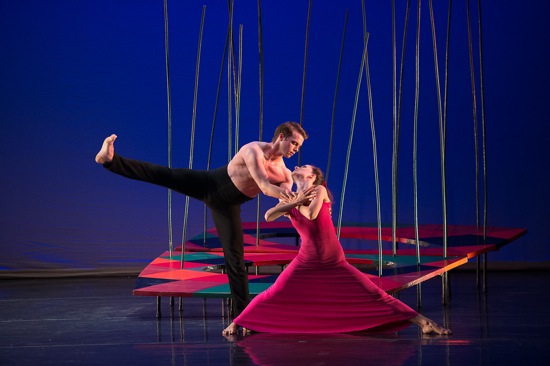
Lloyd Mayor and Marya Dashkina Maddux as Adam and Eve in Embattled Garden. Photo: Christopher Duggan
Jean Rosenthal’s lighting, recreated by Beverly Emmons, adds to the heat of the encounters. In this vivid atmosphere, Graham manipulated erotic tension, jealousy, and desire. The Stranger nuzzles Eve; Adam kisses Lilith behind the red fan she holds up. Eve slaps Adam. Lilith soothes Eve. The two men fight. All may leap convulsively or plunge to the floor or slide their hands down someone else’s body. When Lilith crosses the stage, kicking one leg high in front of her, her ribcage contracting at every step, pain and yearning seem to pull her in opposite directions. Both women swing their hips so forcefully that the action looks more like a threat than an invitation to dalliance. The level of intensity never flags; these people are on fire.
As in many of the dances that Graham made beginning in the late 1940s, no performer leaves the stage. Instead, for instance, Knight and Ellmore-Tallitsch recline under the “tree” and whisper together while Jacobsen and Dashkina Maddux dance. Any one of them may wait in a kind of suspended animation while others move.
Watching Embattled Garden this time, I started wondering about Eve’s hair. Graham designed the role on Yuriko (Kikuchi), who had a very long mane of straight black hair, and it became a symbol of I’m not sure what. Eve is combing her hair dreamily when the curtain goes up. Adam strokes it and pulls her by it. In a complex action underneath the “tree,” Lilith bends Eve back over Knight’s upraised knees (He’s lying on his back) and with a red ribbon binds her hair into a ponytail. In the end, Adam stands on the rim of the pit with Eve sitting below him; slowly he strokes the long swatch of hair up along his body as the other two watch from a distance. The curtain falls. What on earth was Graham thinking? I’d give a lot to know.
Embattled Garden is not one of her masterpieces, but it’s a vibrantly theatrical work, and these four dancers animate it to the hilt—firing up its passions without over-luxuriating in its sexy arguments. Graham turned 65 a month after its premiere. Senior citizenhood be damned!
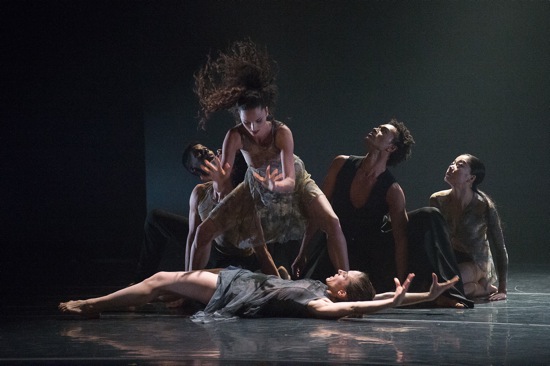
Nacho Duato’s Depak Ine. (L to R): Lloyd Knight, Carrie Ellmore-Tallitsch, Lauren Newman (supine), Abdiel Jacobsen, and Ying Xin. Photo: Christopher Duggan
The other two dances on the program (both of them feeling overly long) also elicited perceptions and responses different from those that I saw on first viewing them. This time, watching Duato’s Depak Ine, the stronger of two pieces, I was struck by the way, at various times, some of the thirteen dancers clump and interlock, staring toward us. They look like a single, entangled entity.
There’s something primal about these people and their domain. Designer Bradley fields has shafted beams of light through clouds and misty. Sounds of nature filter into the electronic piece by John Talabot that gave Duato his title; music by the Serbian radio-composer Arsenije Jovanovic has its eerie moments. There is a body on stage, a woman face down and motionless on the floor (she remains there for a very long time). Barely visible in the dimness, Knight enters bolting along on his belly; a woman scrabbles after him. Throughout the dance, people race away, returning later with equal celerity. In his long skirt (costumes by Angelina Atlagic), Jacobsen may be some kind of high priest; others lean him over the woman’s body. Now and then, someone dances alone: Ellmore-Tallitsch, Lorenzo Pagano, Knight, et al. Knight and Pagano carry Ying Xin between them and run her around. What’s intriguing are the uncomfortable ways in which people hook themselves together, as if there were no approved way of mating or combining their forces.
The “body” turns out to be Chien-Pott, and when she comes to life, she’s a sinuous as a climbing vine, rolling along the floor until three men begin to drag and twist her. In the end, they’re in a heap, and she is perched atop it staring up toward the light. Has this society evolved? Maybe.
When I first saw Foniadakis’s Echo, I liked very much the way various dancers echoed in canon the titular character’s moves. I still like that and almost wished there were more of it. A program note explains, “The work is inspired by the Greek myth of Narcissus and Echo but does not retell their story.” This time, I found myself wishing that Foniadakis had paid a little more attention to that story: Narcissus falls in love with his own reflection in a pond. Echo, who loves him, can only repeat what someone else has said. I would have liked to see Lloyd Mayor and Pagano more often in mirror-image moves and to have sensed which was the flesh-and-blood Narcissus (Mayor) and which his image (Pagano). Most often, they look like lovers embracing, even in a “May I have this dance?” way. At the performance I saw, Mayor was strangely unemotional, while Pagano projected a mischievous pleasure in imitating him.
So, in billowing fog and piercing beams (lighting by Clifton Taylor), to bursts of sound by Julien Tarride, Ying Xin as Echo enters to dance her helplessness and to try to get the “real” Narcissus to pay attention to her. I imagine that Foniadakis and designer Anastasios Sofroniou collaborated on the costumes. Perhaps in garbing all the dancers in long full pleated skirts, they wished to create images of rushing water. The problem is that the dancers can hardly take a few steps without incorporating a turn into their progress, and, since once on the stage, they rarely stop moving, the stage is a sea of whirling fabric. Perhaps telling the story a little more clearly in terms of structural choices might have resulted in more judicious pauses and changes of dynamics.
Never mind, the Saturday night audience loved it—loved almost everything And they rightly honored the company; these avatars of Graham danced magnificently. A few spectators did mention being sad that only one of the four works shown was made by Graham herself. Although I understand the rationale for the program structure, I felt that way too.

